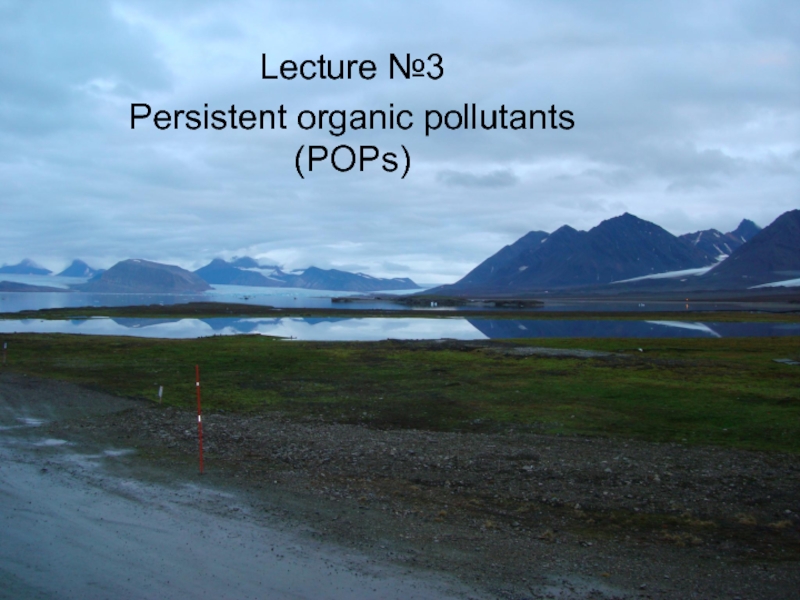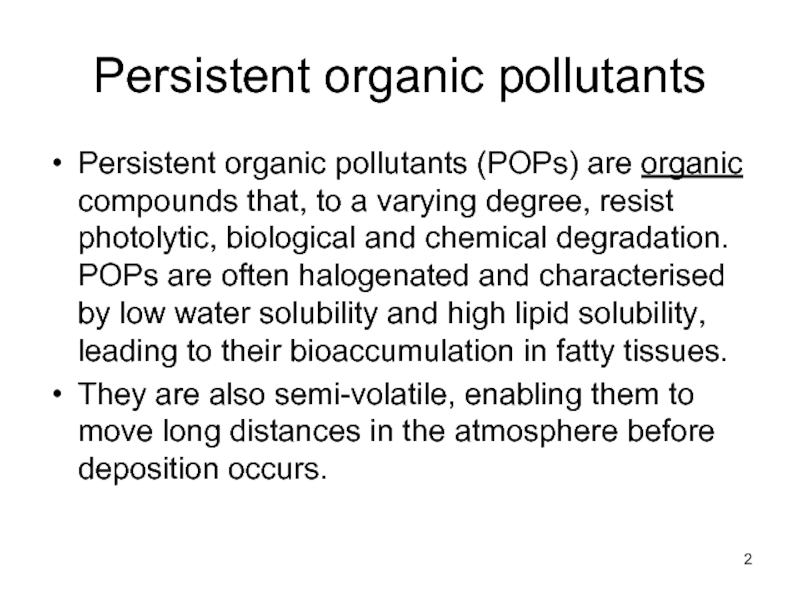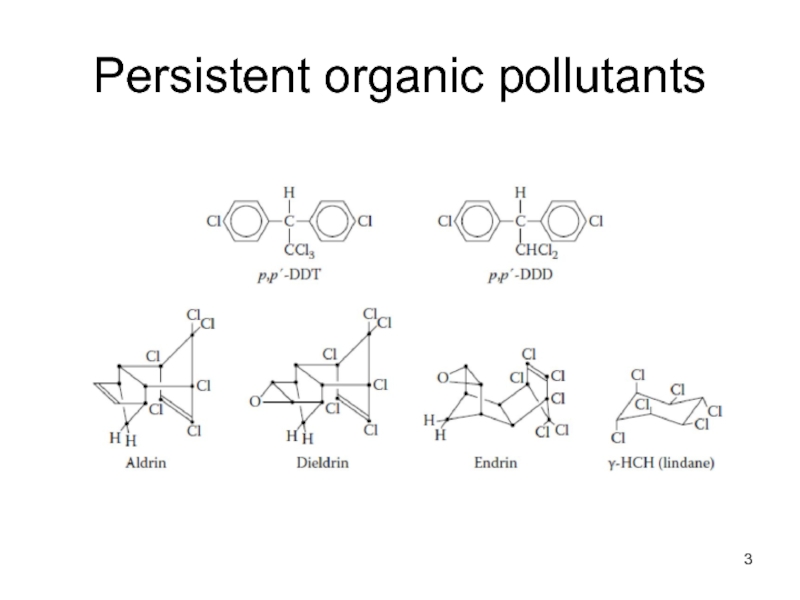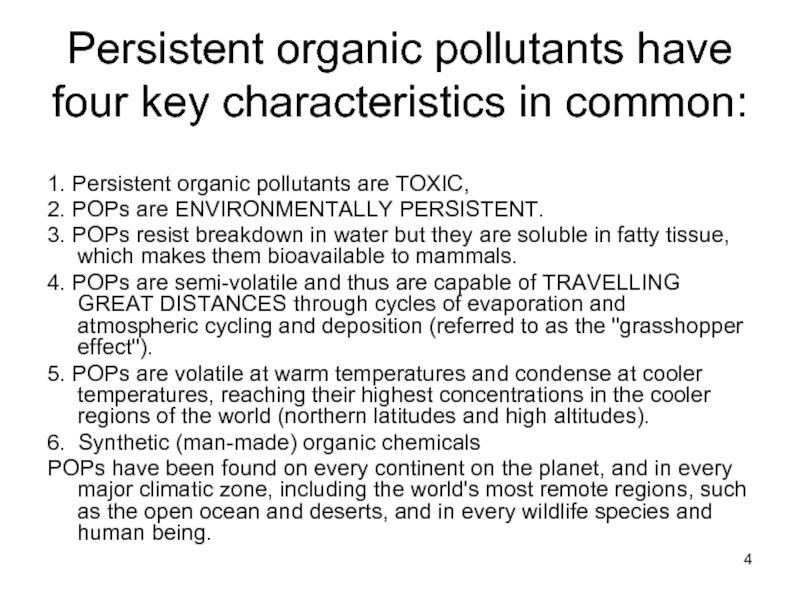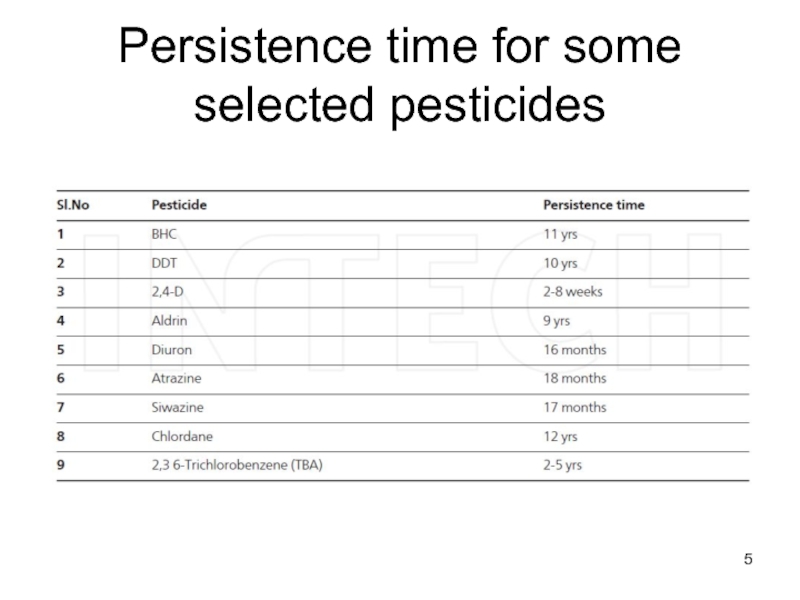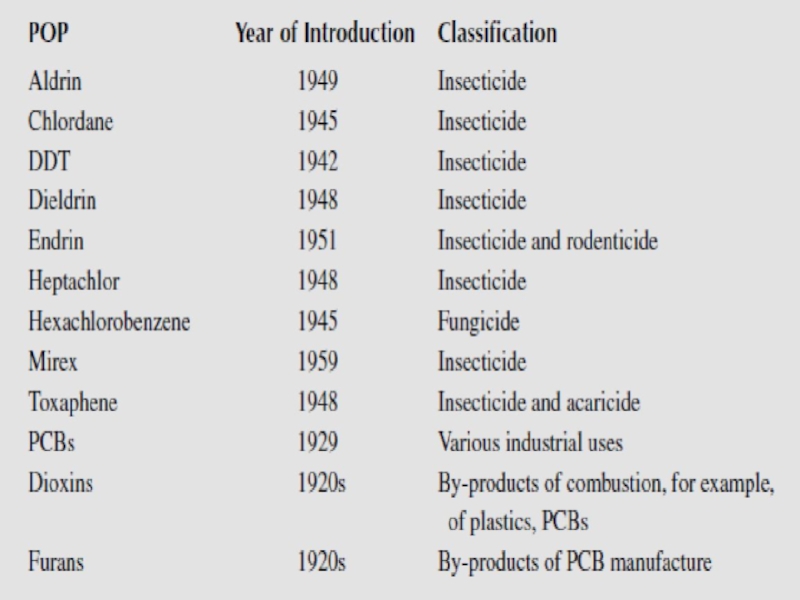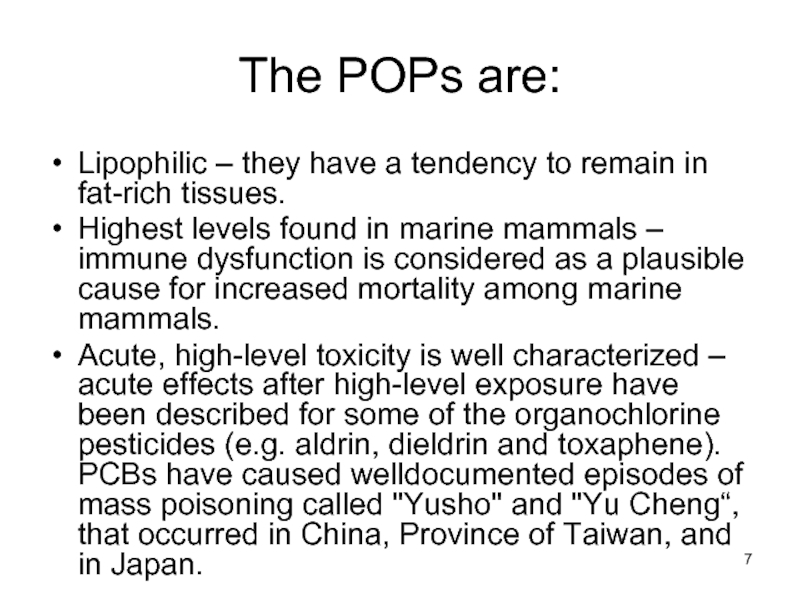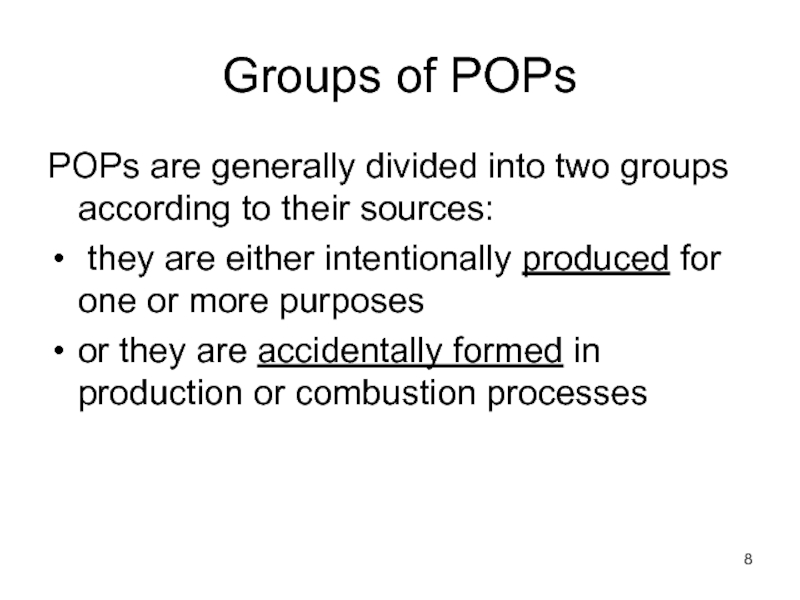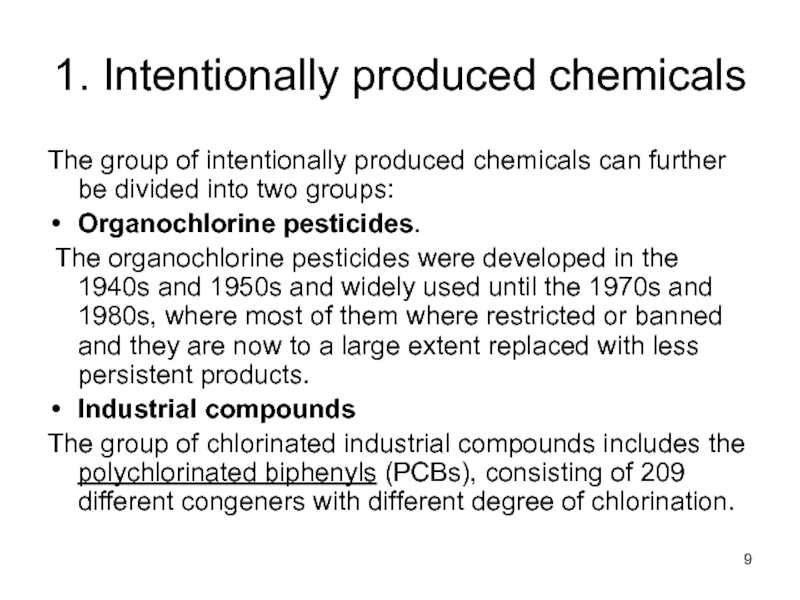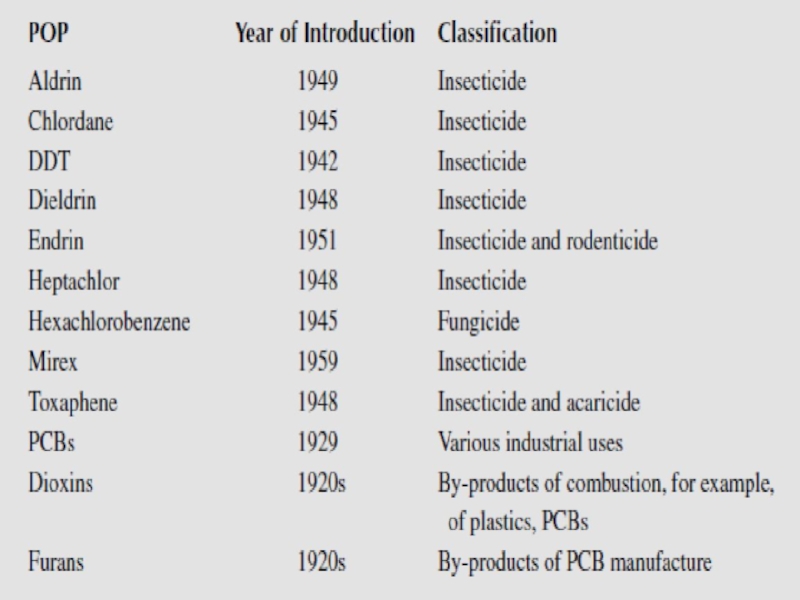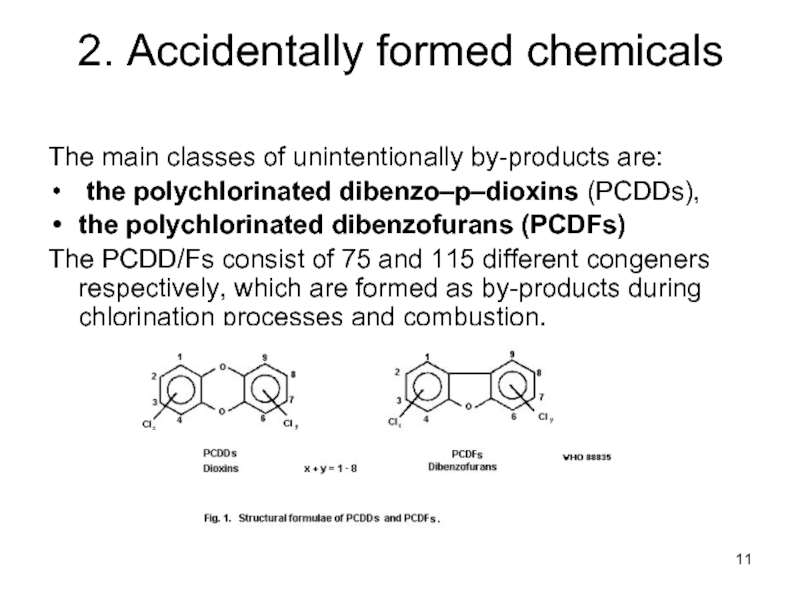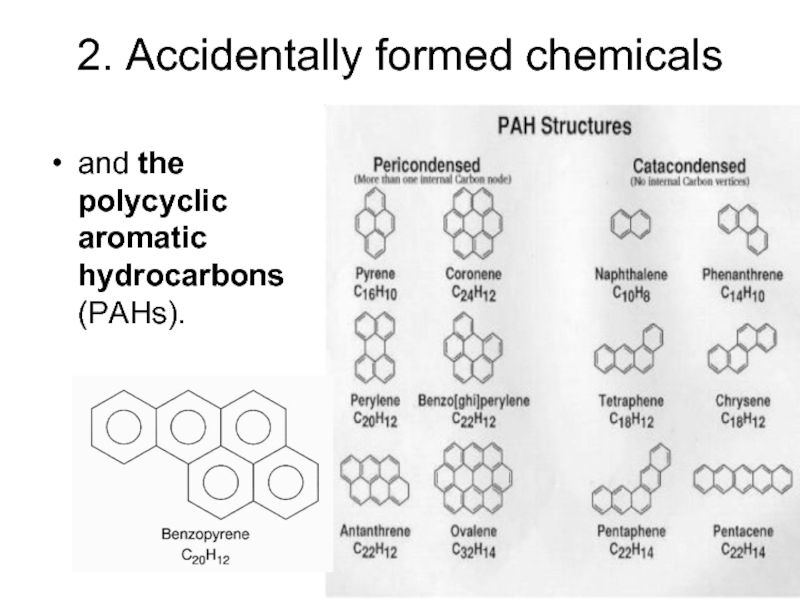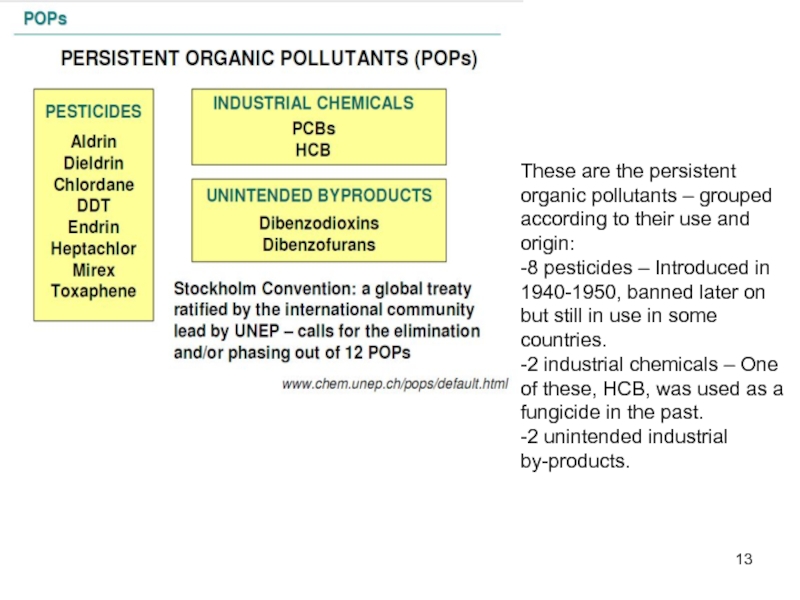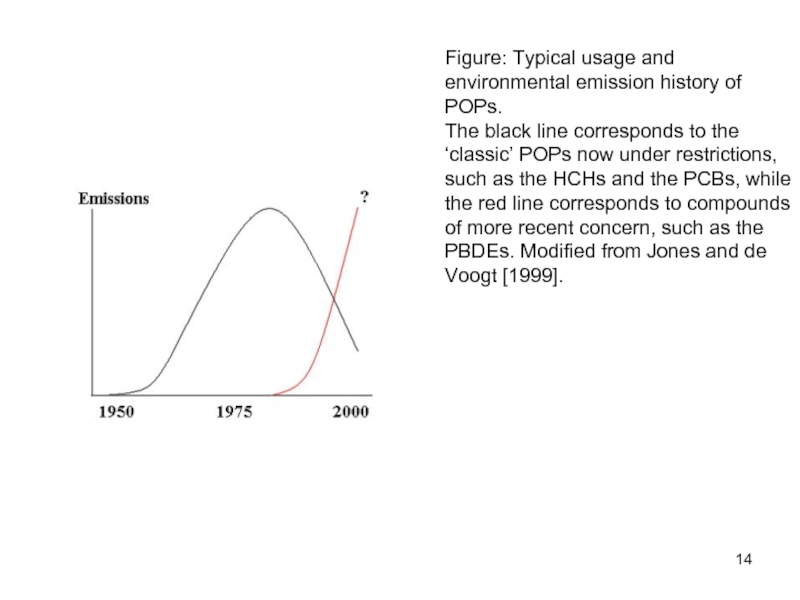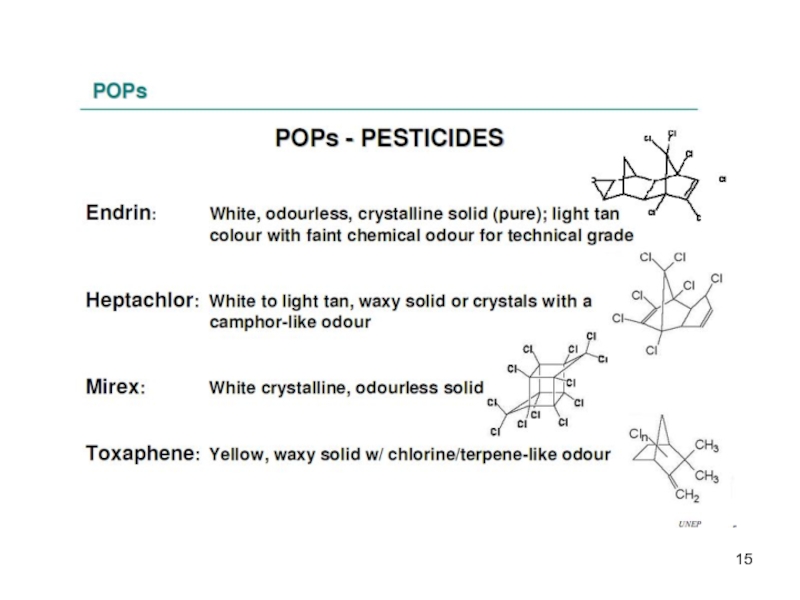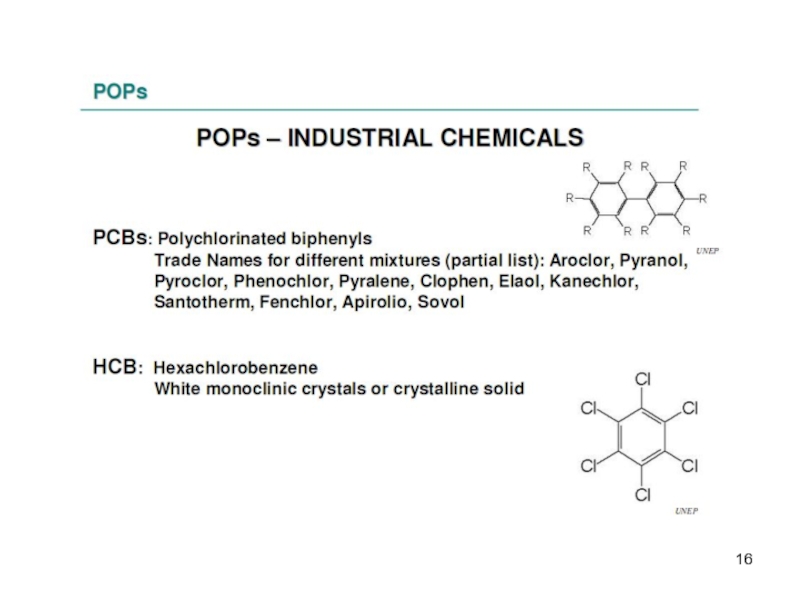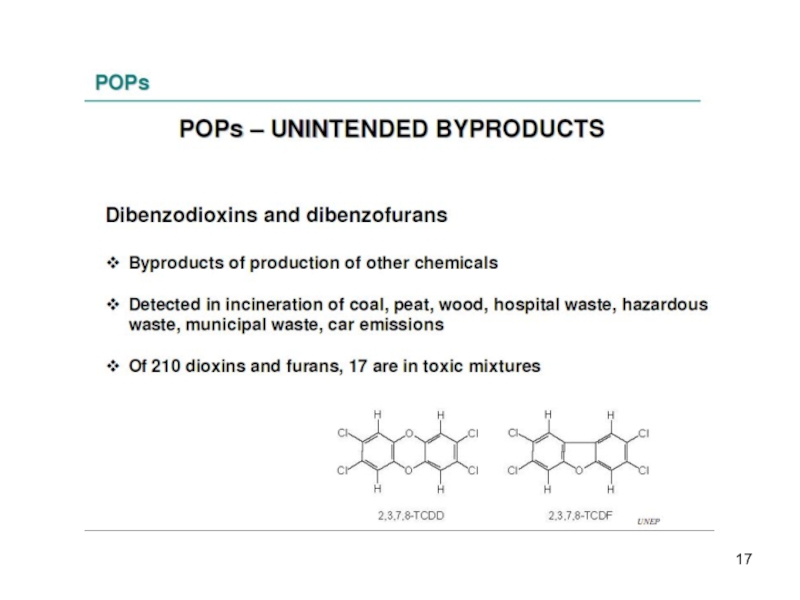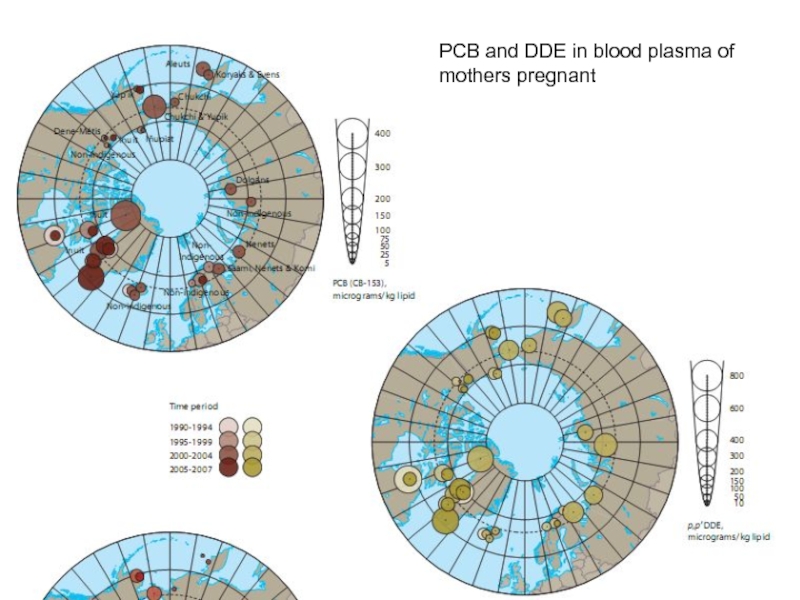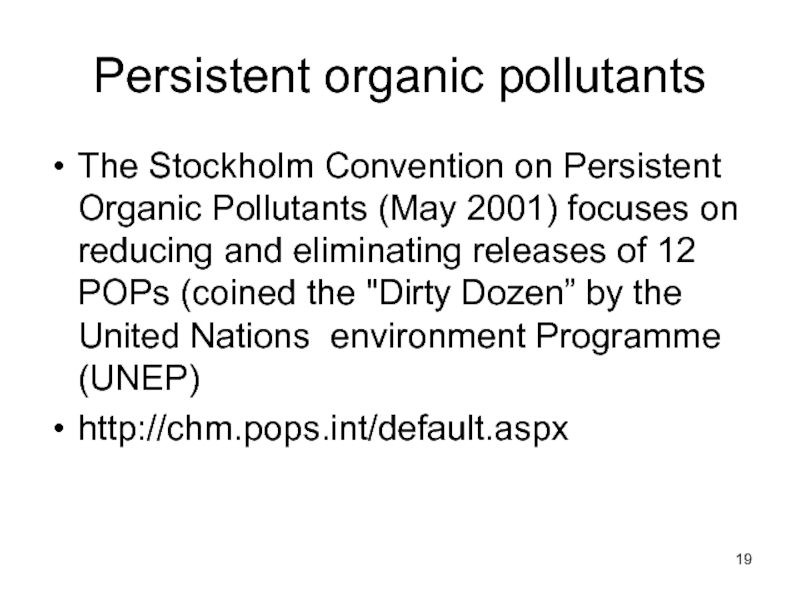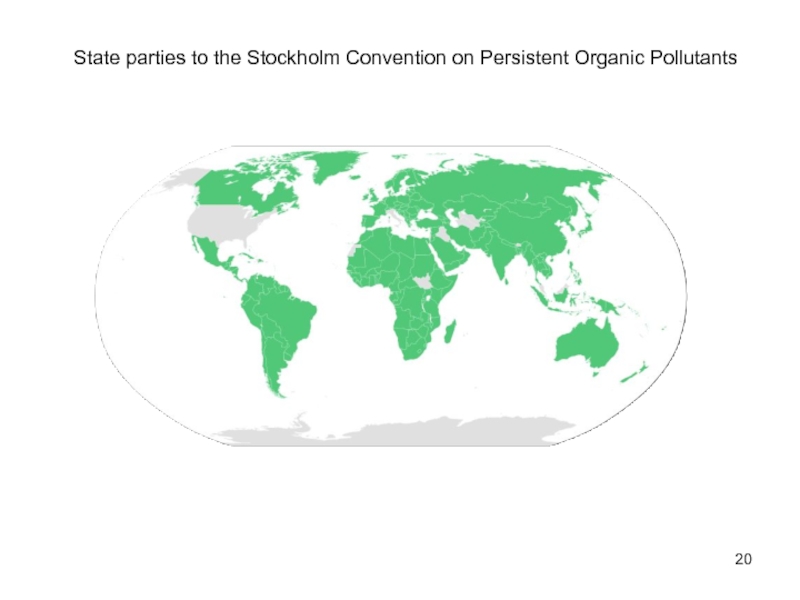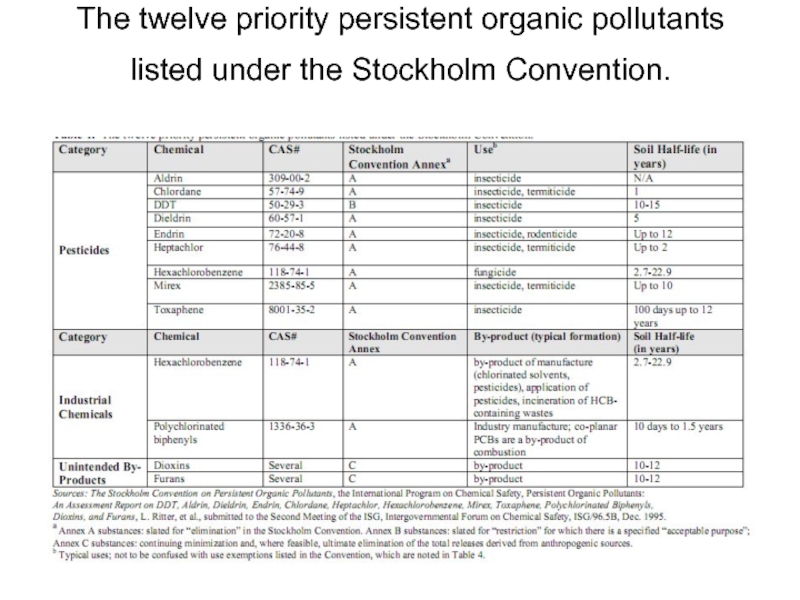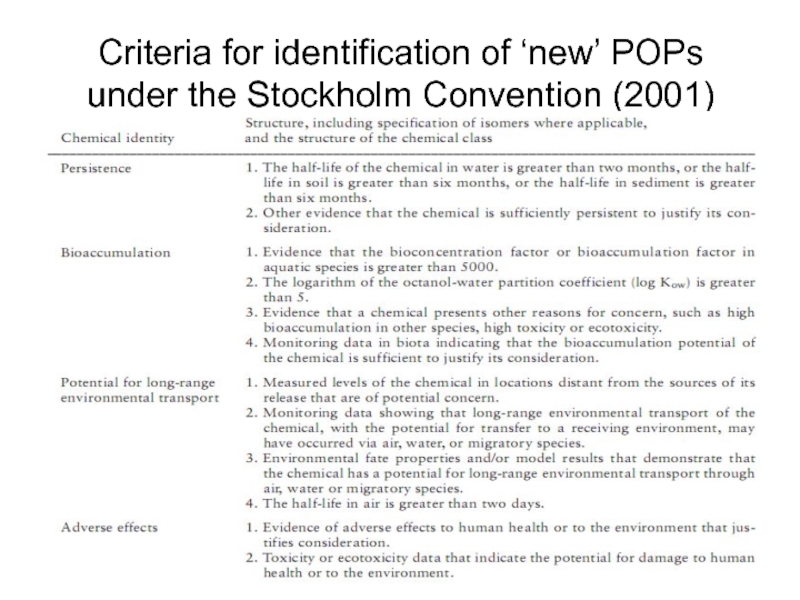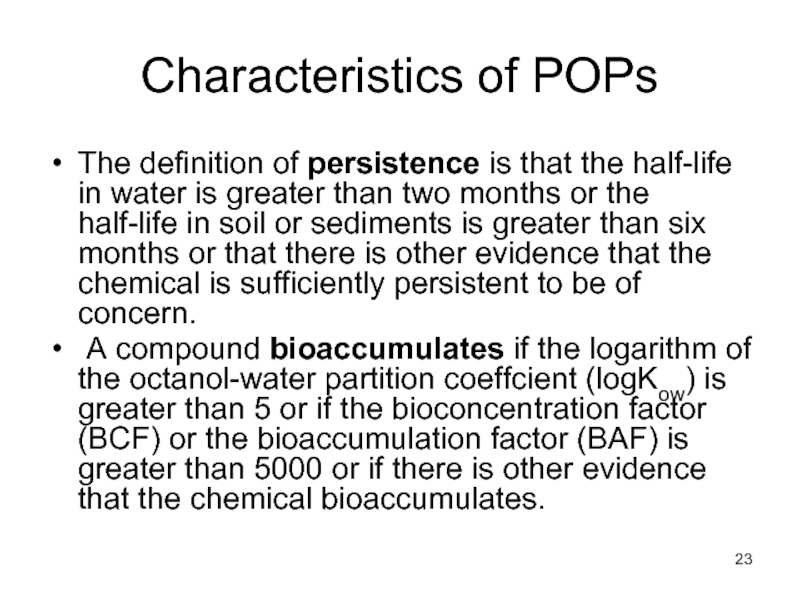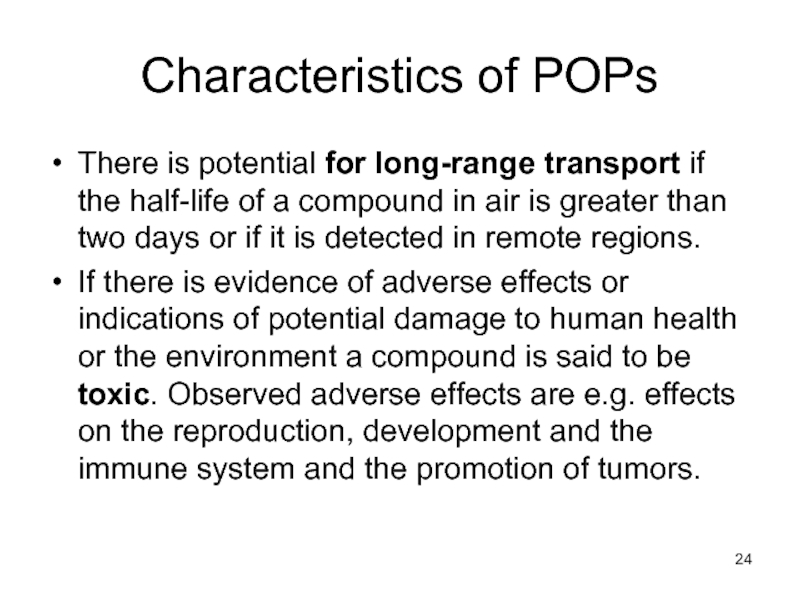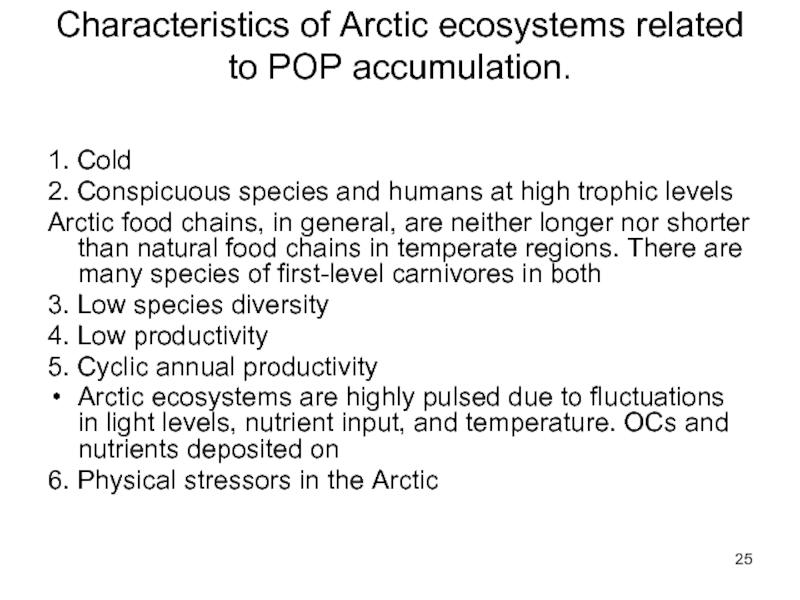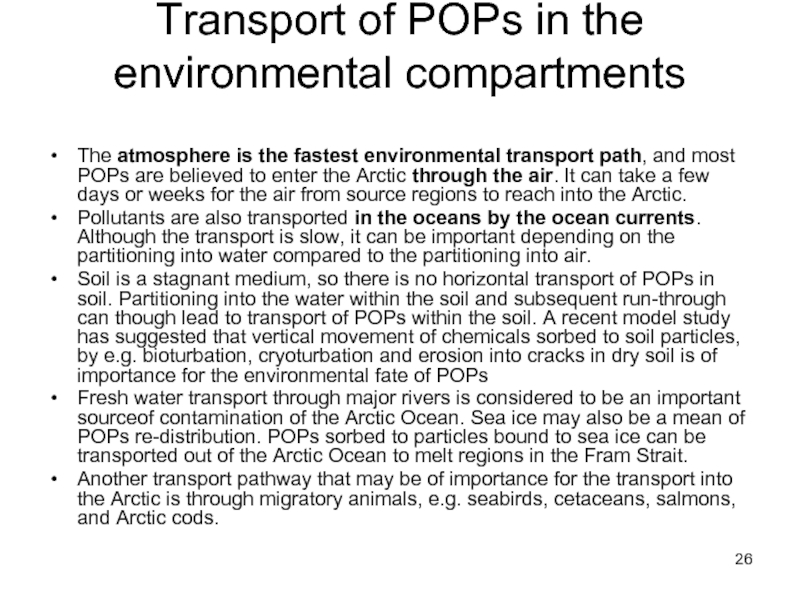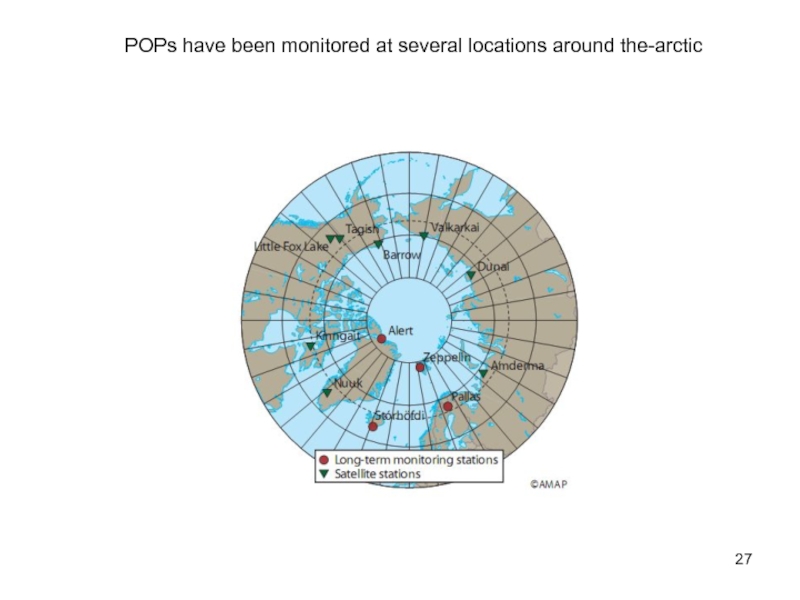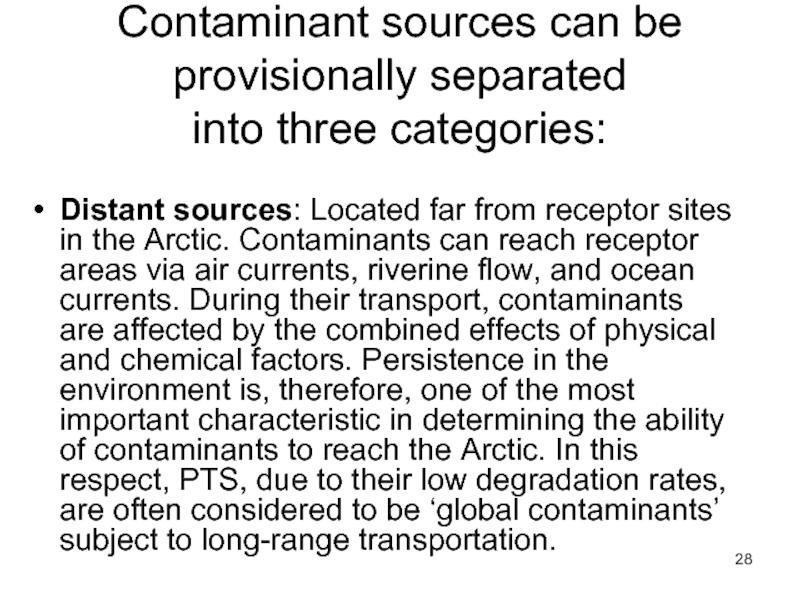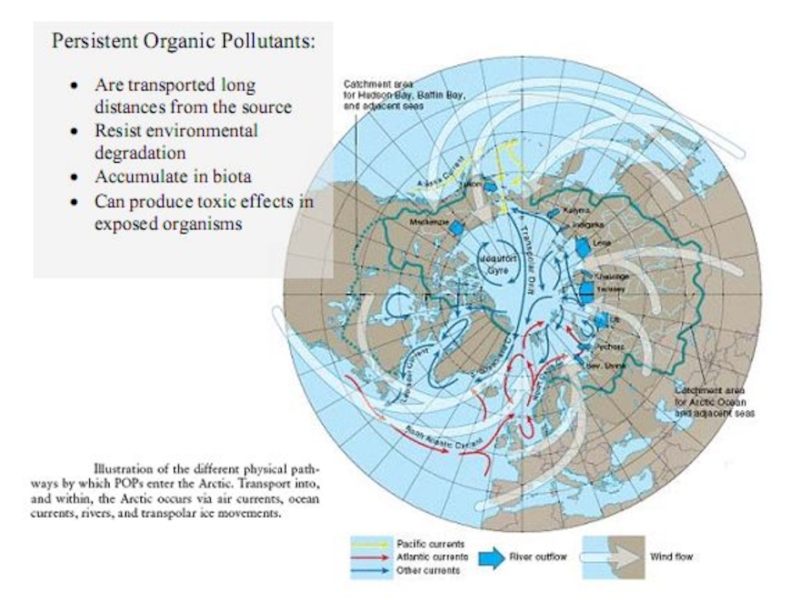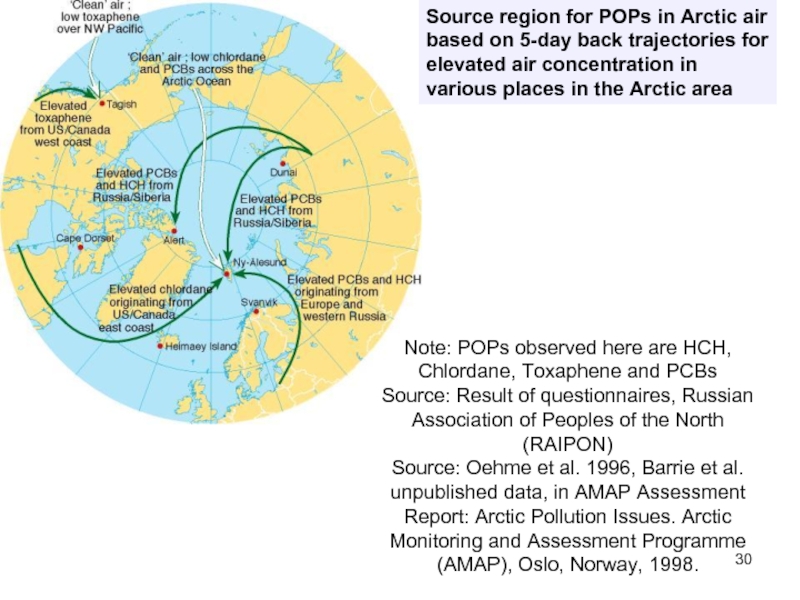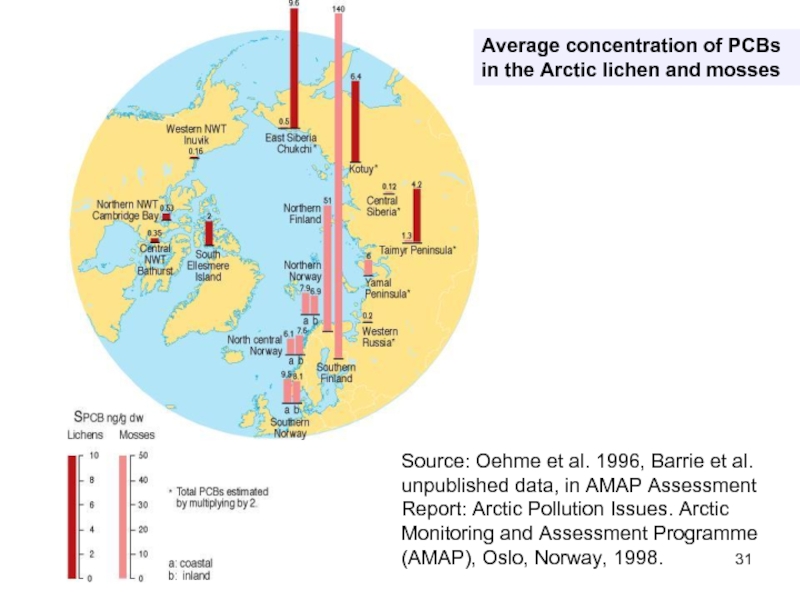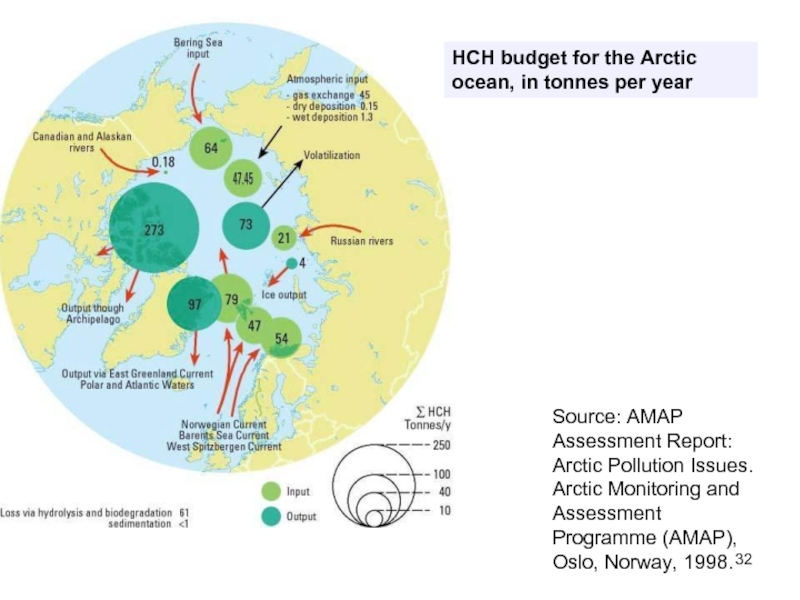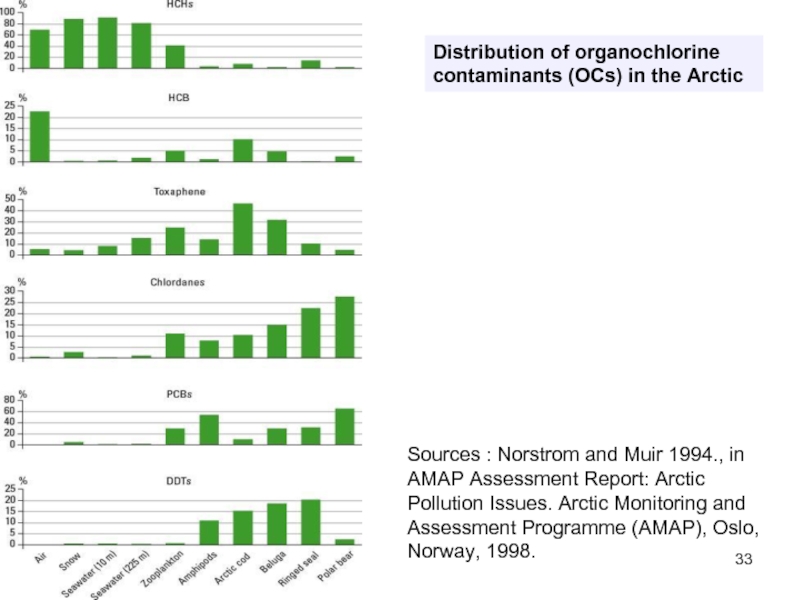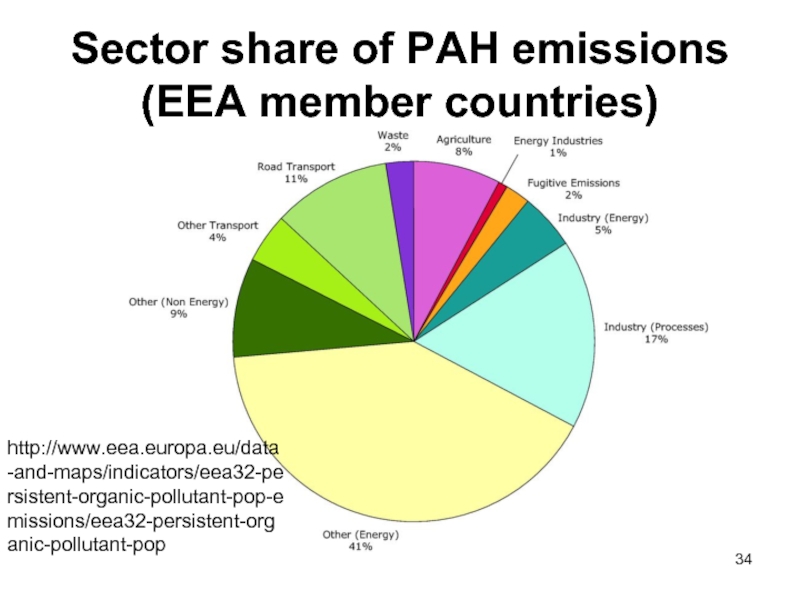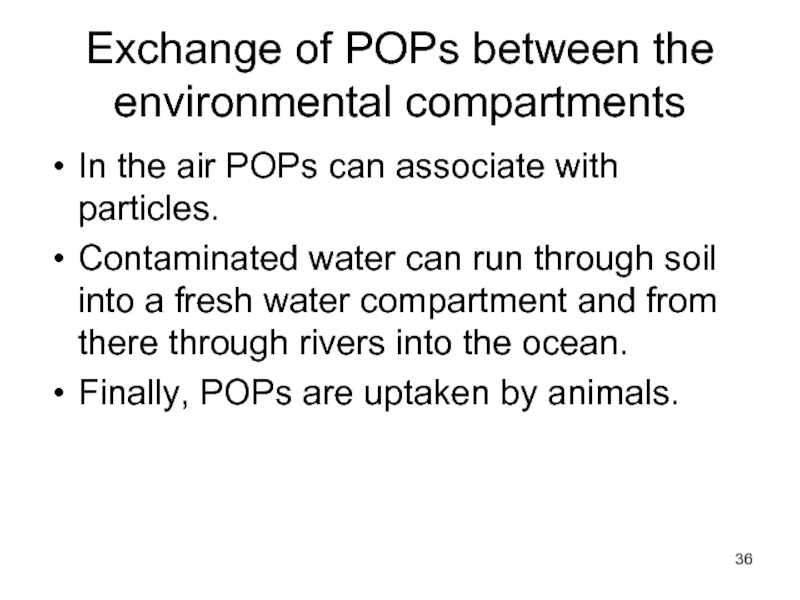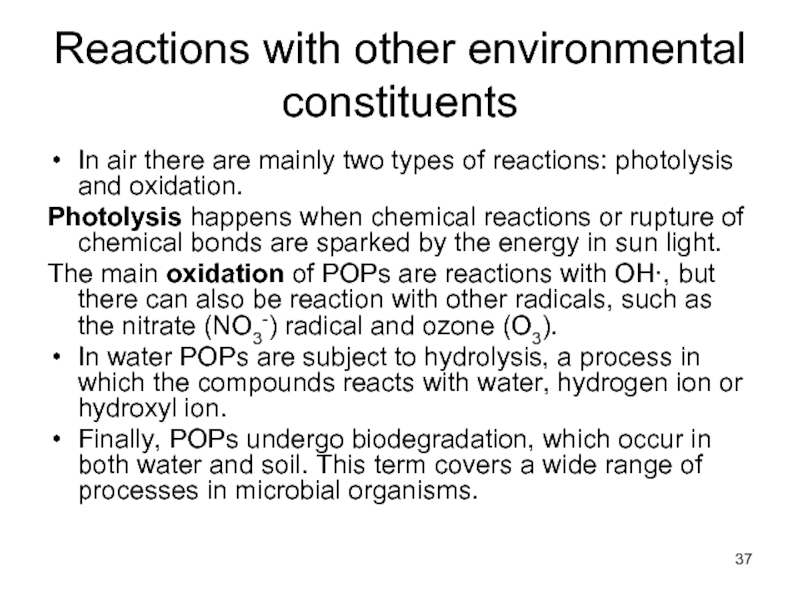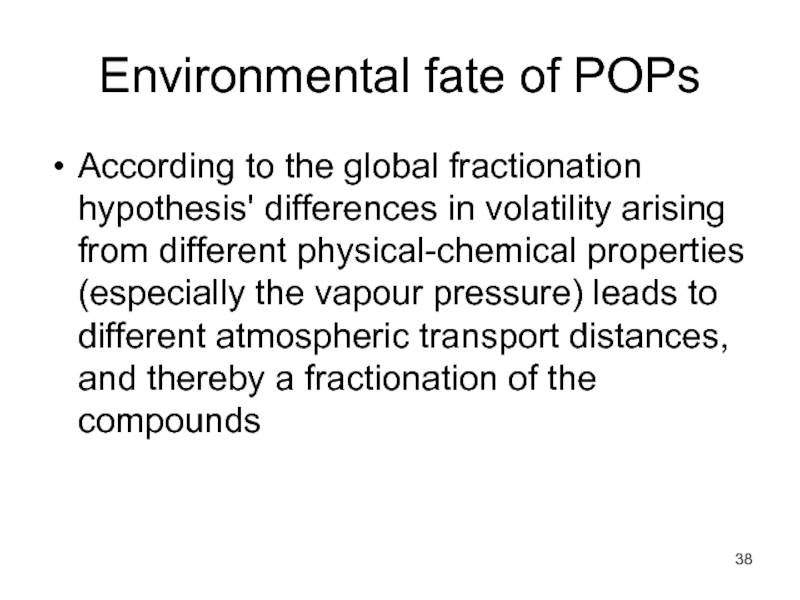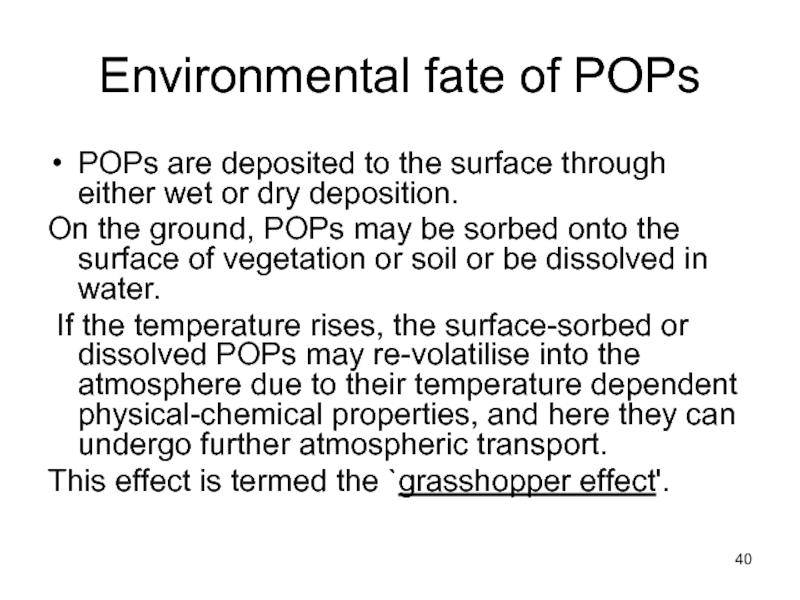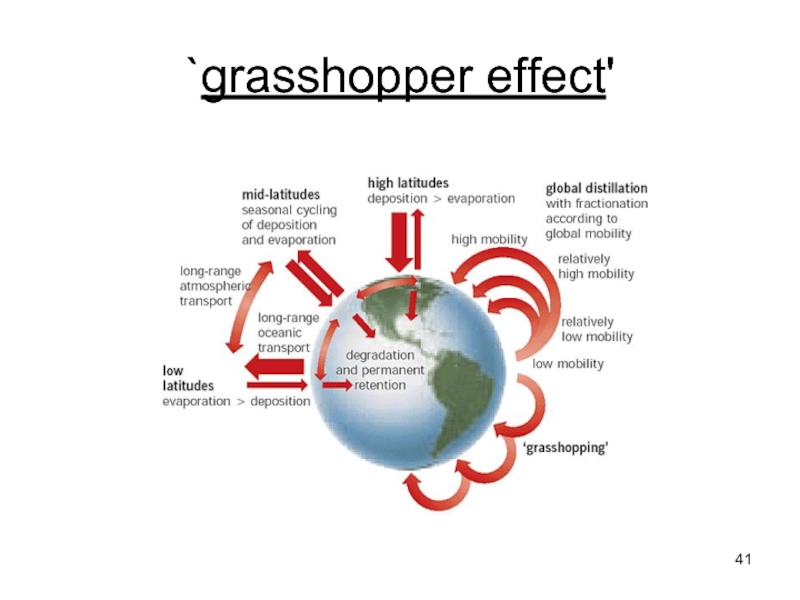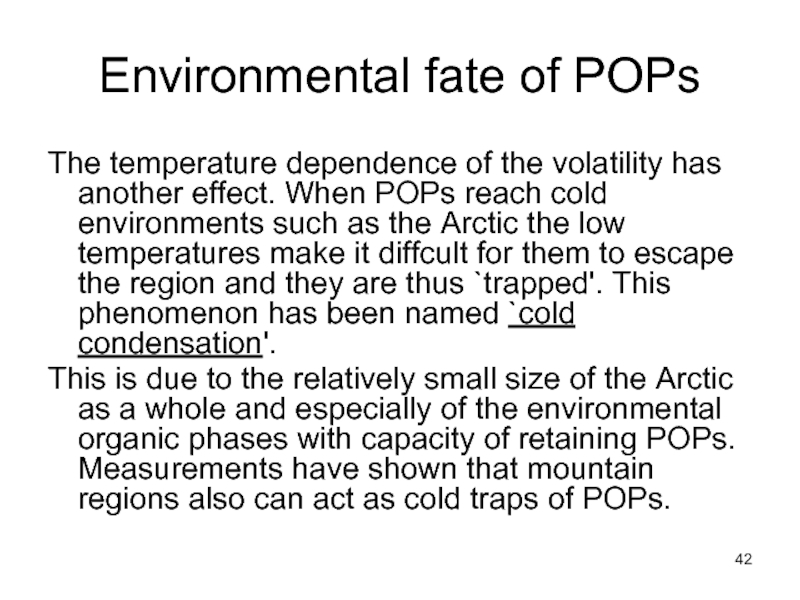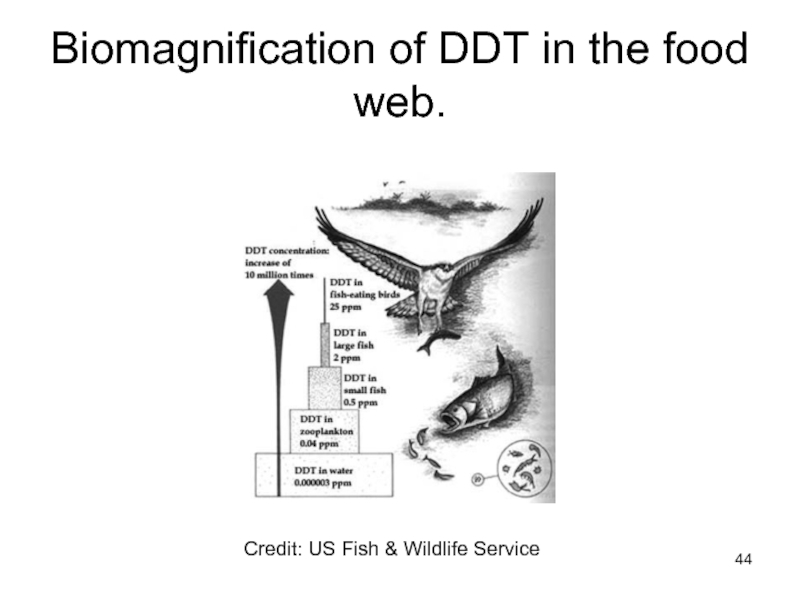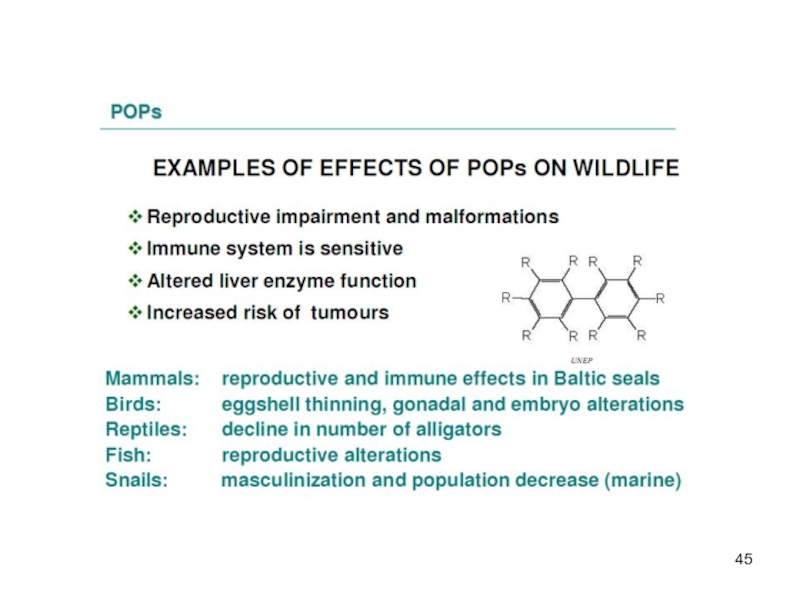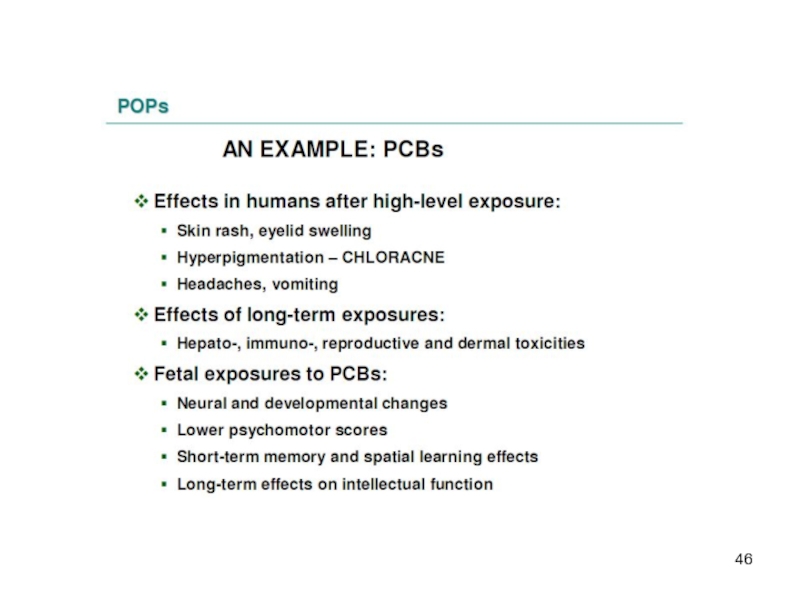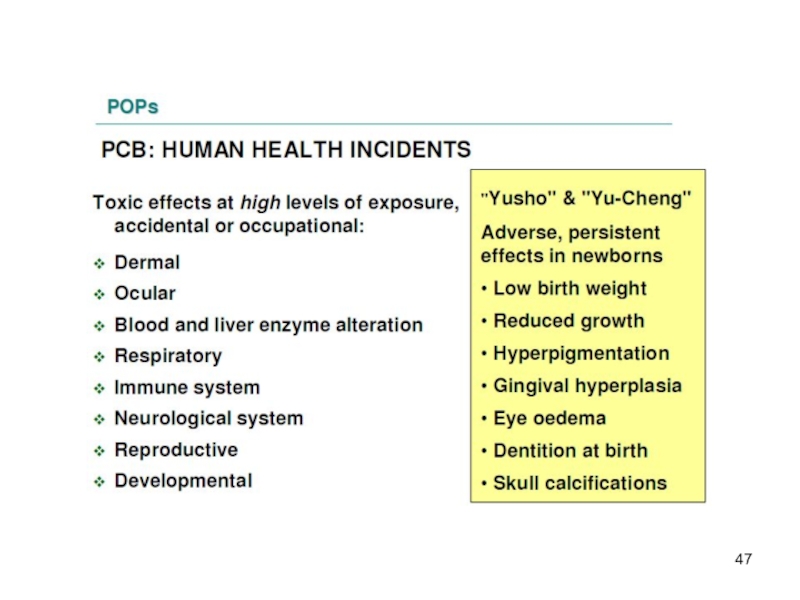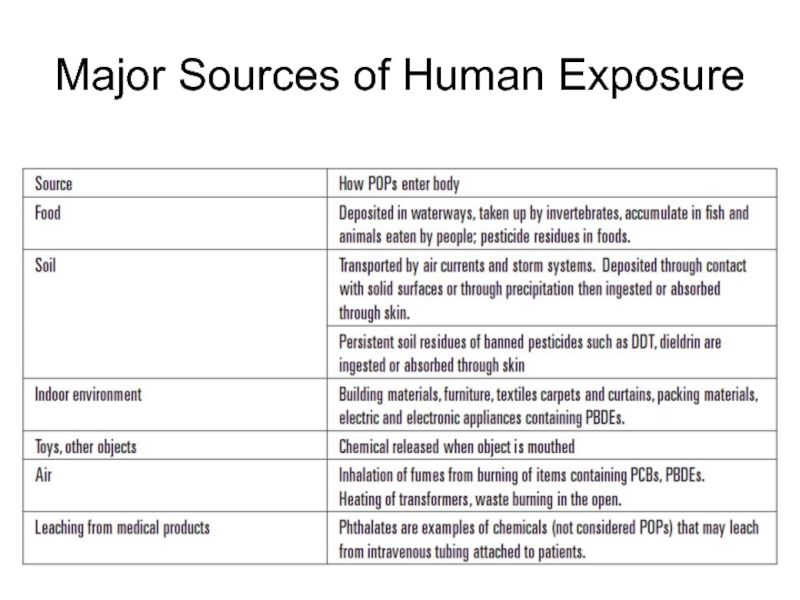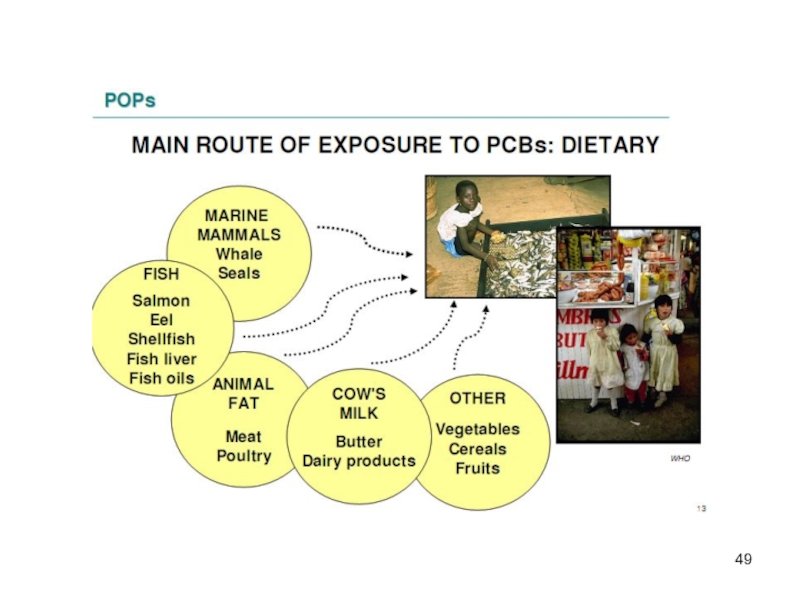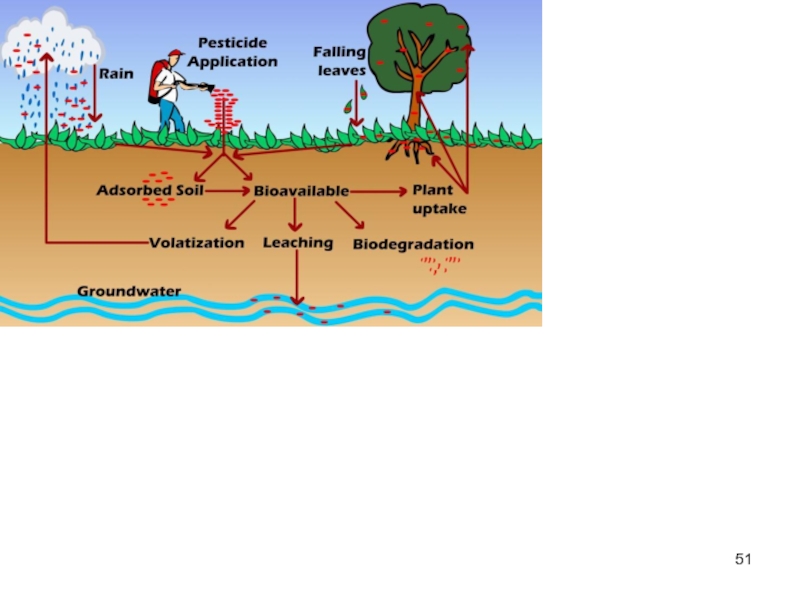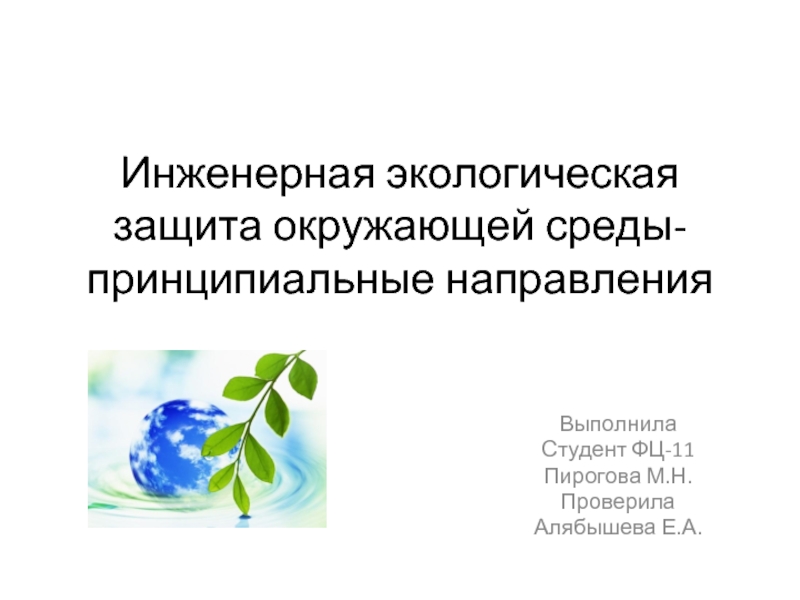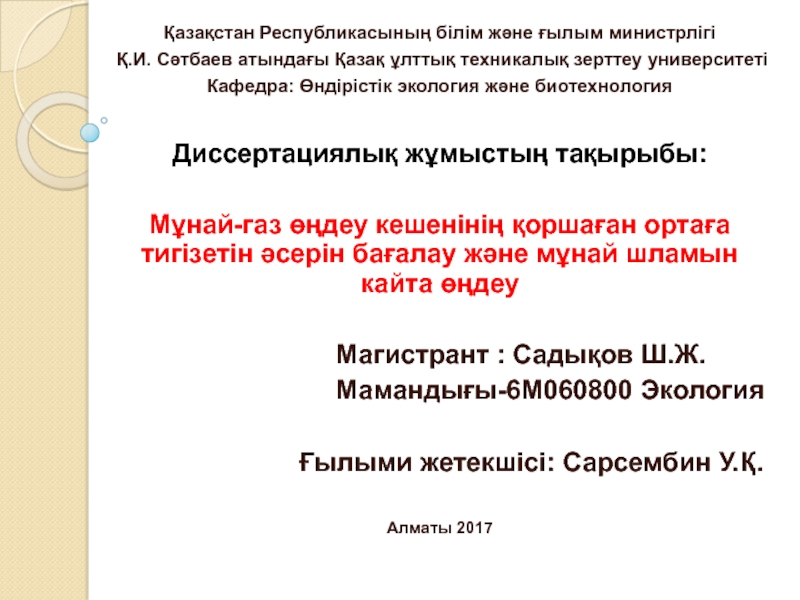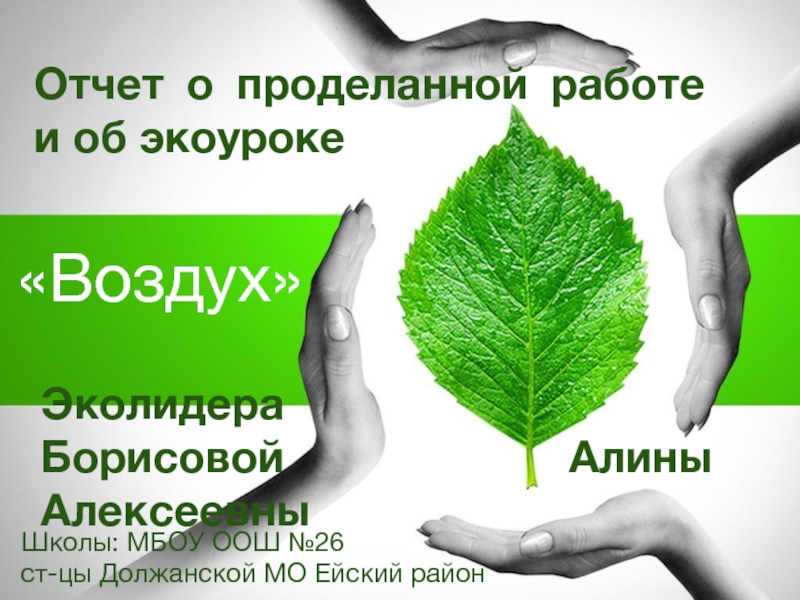- Главная
- Разное
- Дизайн
- Бизнес и предпринимательство
- Аналитика
- Образование
- Развлечения
- Красота и здоровье
- Финансы
- Государство
- Путешествия
- Спорт
- Недвижимость
- Армия
- Графика
- Культурология
- Еда и кулинария
- Лингвистика
- Английский язык
- Астрономия
- Алгебра
- Биология
- География
- Детские презентации
- Информатика
- История
- Литература
- Маркетинг
- Математика
- Медицина
- Менеджмент
- Музыка
- МХК
- Немецкий язык
- ОБЖ
- Обществознание
- Окружающий мир
- Педагогика
- Русский язык
- Технология
- Физика
- Философия
- Химия
- Шаблоны, картинки для презентаций
- Экология
- Экономика
- Юриспруденция
Persistent organic pollutants презентация
Содержание
- 1. Persistent organic pollutants
- 2. Persistent organic pollutants Persistent organic pollutants (POPs)
- 3. Persistent organic pollutants
- 4. Persistent organic pollutants have four key characteristics
- 5. Persistence time for some selected pesticides
- 7. The POPs are: Lipophilic – they have
- 8. Groups of POPs POPs are generally
- 9. 1. Intentionally produced chemicals The group
- 11. 2. Accidentally formed chemicals The main
- 12. 2. Accidentally formed chemicals and the polycyclic aromatic hydrocarbons (PAHs).
- 13. These are the persistent organic pollutants –
- 14. Figure: Typical usage and environmental emission history
- 18. PCB and DDE in blood plasma of mothers pregnant
- 19. Persistent organic pollutants The Stockholm Convention on
- 20. State parties to the Stockholm Convention on Persistent Organic Pollutants
- 21. The twelve priority persistent organic pollutants listed under the Stockholm Convention.
- 22. Criteria for identification of ‘new’ POPs under the Stockholm Convention (2001)
- 23. Characteristics of POPs The definition of
- 24. Characteristics of POPs There is potential for
- 25. Characteristics of Arctic ecosystems related to POP
- 26. Transport of POPs in the environmental compartments
- 27. POPs have been monitored at several locations around the-arctic
- 28. Contaminant sources can be provisionally separated into
- 30. Source region for POPs in Arctic air
- 31. Average concentration of PCBs in the Arctic
- 32. HCH budget for the Arctic ocean, in
- 33. Distribution of organochlorine contaminants (OCs) in the
- 34. Sector share of PAH emissions (EEA member countries) http://www.eea.europa.eu/data-and-maps/indicators/eea32-persistent-organic-pollutant-pop-emissions/eea32-persistent-organic-pollutant-pop
- 35. Estimated Percent Contribution of Sector Dioxins and Furans Releases to the Atmosphere (1999) https://www.ec.gc.ca/lcpe-cepa/default.asp?lang=En&n=CAE9F571=1&wsdoc=A027B74F-FAC4-DC47-CDC0-B41DDEAE61AD
- 36. Exchange of POPs between the environmental compartments
- 37. Reactions with other environmental constituents In air
- 38. Environmental fate of POPs According to the
- 39. Figure: An illustration of `the global fractionation'
- 40. Environmental fate of POPs POPs are deposited
- 41. `grasshopper effect'
- 42. Environmental fate of POPs The temperature dependence
- 44. Biomagnification of DDT in the food web. Credit: US Fish & Wildlife Service
- 48. Major Sources of Human Exposure
Слайд 2Persistent organic pollutants
Persistent organic pollutants (POPs) are organic compounds that, to
They are also semi-volatile, enabling them to move long distances in the atmosphere before deposition occurs.
Слайд 4Persistent organic pollutants have four key characteristics in common:
1. Persistent organic
2. POPs are ENVIRONMENTALLY PERSISTENT.
3. POPs resist breakdown in water but they are soluble in fatty tissue, which makes them bioavailable to mammals.
4. POPs are semi-volatile and thus are capable of TRAVELLING GREAT DISTANCES through cycles of evaporation and atmospheric cycling and deposition (referred to as the "grasshopper effect").
5. POPs are volatile at warm temperatures and condense at cooler temperatures, reaching their highest concentrations in the cooler regions of the world (northern latitudes and high altitudes).
6. Synthetic (man-made) organic chemicals
POPs have been found on every continent on the planet, and in every major climatic zone, including the world's most remote regions, such as the open ocean and deserts, and in every wildlife species and human being.
Слайд 7The POPs are:
Lipophilic – they have a tendency to remain in
Highest levels found in marine mammals – immune dysfunction is considered as a plausible cause for increased mortality among marine mammals.
Acute, high-level toxicity is well characterized – acute effects after high-level exposure have been described for some of the organochlorine pesticides (e.g. aldrin, dieldrin and toxaphene). PCBs have caused welldocumented episodes of mass poisoning called "Yusho" and "Yu Cheng“, that occurred in China, Province of Taiwan, and in Japan.
Слайд 8Groups of POPs
POPs are generally divided into two groups according
they are either intentionally produced for one or more purposes
or they are accidentally formed in production or combustion processes
Слайд 91. Intentionally produced chemicals
The group of intentionally produced chemicals can
Organochlorine pesticides.
The organochlorine pesticides were developed in the 1940s and 1950s and widely used until the 1970s and 1980s, where most of them where restricted or banned and they are now to a large extent replaced with less persistent products.
Industrial compounds
The group of chlorinated industrial compounds includes the polychlorinated biphenyls (PCBs), consisting of 209 different congeners with different degree of chlorination.
Слайд 112. Accidentally formed chemicals
The main classes of unintentionally by-products are:
the polychlorinated dibenzofurans (PCDFs)
The PCDD/Fs consist of 75 and 115 different congeners respectively, which are formed as by-products during chlorination processes and combustion.
Слайд 13These are the persistent organic pollutants – grouped according to their
-8 pesticides – Introduced in 1940-1950, banned later on but still in use in some countries.
-2 industrial chemicals – One of these, HCB, was used as a fungicide in the past.
-2 unintended industrial by-products.
Слайд 14Figure: Typical usage and environmental emission history of POPs.
The black
Слайд 19Persistent organic pollutants
The Stockholm Convention on Persistent Organic Pollutants (May 2001)
http://chm.pops.int/default.aspx
Слайд 23Characteristics of POPs
The definition of persistence is that the half-life
A compound bioaccumulates if the logarithm of the octanol-water partition coeffcient (logKow) is greater than 5 or if the bioconcentration factor (BCF) or the bioaccumulation factor (BAF) is greater than 5000 or if there is other evidence that the chemical bioaccumulates.
Слайд 24Characteristics of POPs
There is potential for long-range transport if the half-life
If there is evidence of adverse effects or indications of potential damage to human health or the environment a compound is said to be toxic. Observed adverse effects are e.g. effects on the reproduction, development and the immune system and the promotion of tumors.
Слайд 25Characteristics of Arctic ecosystems related to POP accumulation.
1. Cold
2. Conspicuous species
Arctic food chains, in general, are neither longer nor shorter than natural food chains in temperate regions. There are many species of first-level carnivores in both
3. Low species diversity
4. Low productivity
5. Cyclic annual productivity
Arctic ecosystems are highly pulsed due to fluctuations in light levels, nutrient input, and temperature. OCs and nutrients deposited on
6. Physical stressors in the Arctic
Слайд 26Transport of POPs in the environmental compartments
The atmosphere is the fastest
Pollutants are also transported in the oceans by the ocean currents. Although the transport is slow, it can be important depending on the partitioning into water compared to the partitioning into air.
Soil is a stagnant medium, so there is no horizontal transport of POPs in soil. Partitioning into the water within the soil and subsequent run-through can though lead to transport of POPs within the soil. A recent model study has suggested that vertical movement of chemicals sorbed to soil particles, by e.g. bioturbation, cryoturbation and erosion into cracks in dry soil is of importance for the environmental fate of POPs
Fresh water transport through major rivers is considered to be an important sourceof contamination of the Arctic Ocean. Sea ice may also be a mean of POPs re-distribution. POPs sorbed to particles bound to sea ice can be transported out of the Arctic Ocean to melt regions in the Fram Strait.
Another transport pathway that may be of importance for the transport into the Arctic is through migratory animals, e.g. seabirds, cetaceans, salmons, and Arctic cods.
Слайд 28Contaminant sources can be provisionally separated
into three categories:
Distant sources: Located
Слайд 30Source region for POPs in Arctic air based on 5-day back
Note: POPs observed here are HCH, Chlordane, Toxaphene and PCBs
Source: Result of questionnaires, Russian Association of Peoples of the North (RAIPON)
Source: Oehme et al. 1996, Barrie et al. unpublished data, in AMAP Assessment Report: Arctic Pollution Issues. Arctic Monitoring and Assessment Programme (AMAP), Oslo, Norway, 1998.
Слайд 31Average concentration of PCBs in the Arctic lichen and mosses
Source:
Слайд 32HCH budget for the Arctic ocean, in tonnes per year
Source:
Слайд 33Distribution of organochlorine contaminants (OCs) in the Arctic
Sources : Norstrom
Слайд 34Sector share of PAH emissions (EEA member countries)
http://www.eea.europa.eu/data-and-maps/indicators/eea32-persistent-organic-pollutant-pop-emissions/eea32-persistent-organic-pollutant-pop
Слайд 35 Estimated Percent Contribution of Sector Dioxins and Furans Releases to the
https://www.ec.gc.ca/lcpe-cepa/default.asp?lang=En&n=CAE9F571=1&wsdoc=A027B74F-FAC4-DC47-CDC0-B41DDEAE61AD
Слайд 36Exchange of POPs between the environmental compartments
In the air POPs can
Contaminated water can run through soil into a fresh water compartment and from there through rivers into the ocean.
Finally, POPs are uptaken by animals.
Слайд 37Reactions with other environmental constituents
In air there are mainly two types
Photolysis happens when chemical reactions or rupture of chemical bonds are sparked by the energy in sun light.
The main oxidation of POPs are reactions with OH·, but there can also be reaction with other radicals, such as the nitrate (NO3-) radical and ozone (O3).
In water POPs are subject to hydrolysis, a process in which the compounds reacts with water, hydrogen ion or hydroxyl ion.
Finally, POPs undergo biodegradation, which occur in both water and soil. This term covers a wide range of processes in microbial organisms.
Слайд 38Environmental fate of POPs
According to the global fractionation hypothesis' differences in
Слайд 39Figure: An illustration of `the global fractionation' hypothesis. Differences in volatility
Слайд 40Environmental fate of POPs
POPs are deposited to the surface through either
On the ground, POPs may be sorbed onto the surface of vegetation or soil or be dissolved in water.
If the temperature rises, the surface-sorbed or dissolved POPs may re-volatilise into the atmosphere due to their temperature dependent physical-chemical properties, and here they can undergo further atmospheric transport.
This effect is termed the `grasshopper effect'.
Слайд 42Environmental fate of POPs
The temperature dependence of the volatility has another
This is due to the relatively small size of the Arctic as a whole and especially of the environmental organic phases with capacity of retaining POPs. Measurements have shown that mountain regions also can act as cold traps of POPs.
